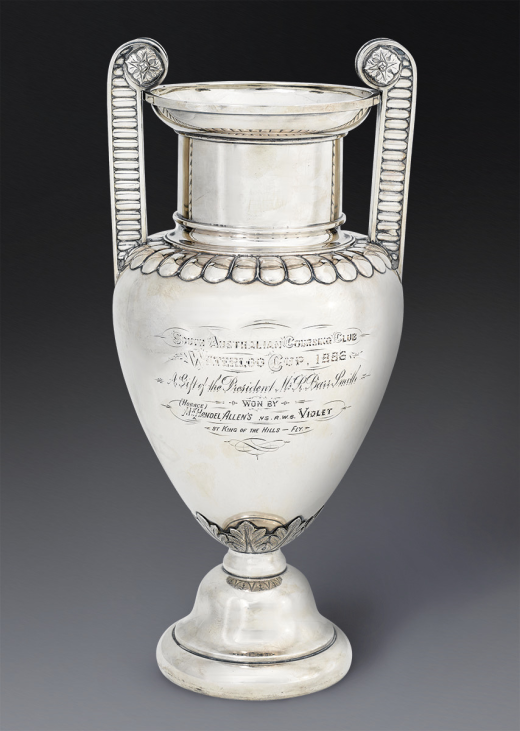The 1886 South Australian Coursing Club Waterloo Cup, by Henry Steiner 1835-1914 Adelaide, circa 1882-1883
Estimate $15,000 – $20,000
PROPERTY FROM THE ESTATE OF THE LATE DR JAN ALTMANN, MELBOURNE
of volute krater form, on a circular stepped bell form base, the body supported on a waisted stem surmounted by a finely chased acanthus leaf collar, the body inscribed 'SOUTH AUSTRALIAN COURSING CLUB / WATERLOO CUP, 1886 / A Gift of the President Mr. R. Barr Smith / WON BY / MR. [HORACE] HANDEL ALLEN'S NS. R.W.B. VIOLET / BY KING OF THE HILLS - FLY' gadrooned to the shoulder from which emanate two gadrooned volute handles centred by rosettes, flanking a waisted neck
stamped 'H. STEINER', 'ADELAIDE', with crown, queen's head and lion passant to base
35 cm high
Provenance
August Brunkhorst 1846-1919 Adelaide (retailer)
The John and Jan Altmann Collection, Melbourne
Exhibited
Australian Silver 1800-1900, Lindesay", Darling Point, Sydney, 1973, no. 97
The J. & J. Altmann Collection of Australian Silver, National Gallery of Victoria, Melbourne, 2 September - 1 November 1981, no. 33 (illustrated)
Australian Decorative Arts 1788-1900, Australian National Gallery, Canberra, 5 November 1988 - 5 February 1989"
Literature
South Australian Coursing Club', The South Australian Advertiser, Adelaide, 20 January 1886, p. 7
The South Australian Weekly Chronicle, Adelaide, 1 May 1886, p. 14
'South Australian Coursing Club: Buckland Park Meet - May 19, 20 and 21, 1886', The South Australian Register, Adelaide, 22 May 1886, p. 7
'Sporting', The South Australian Register, Adelaide, 2 June 1886, p. 7
John Hawkins, Australian Silver 1800 - 1900, National Trust of Australia (New South Wales) Women's Committee, Sydney, 1973, pp. 72, 84
|
|
Alison AlfordConsultant Arts & DesignSydney T: +61 (0)2 9302 2402 E: Alison Alford |
|
Ann RobertsConsultant, Asian Art Arts & DesignMelbourne T: +61 (0)3 9508 9900 E: Ann Roberts |
|
|
Harley YoungSpecialist Arts & DesignMelbourne T: +61 (0)3 9508 9900 E: Harley Young |
|
Anthony HurlConsultant Arts & DesignAdelaide T: +61 (0)8 7225 7836 E: Anthony Hurl |
|
|
Philip A. GoreConsultant, Clocks, Barometers & Scientific Instruments Arts & Design |






